The Tripletail is a fascinating and somewhat mysterious species known for its distinctive body shape and behavior. This fish is named for its appearance, with its large dorsal and anal fins extending almost to its tail, giving the illusion of having three tails. Often found in warm coastal waters, the Tripletail can be elusive, making it crucial to understand its habits and habitats for those aiming to catch one.
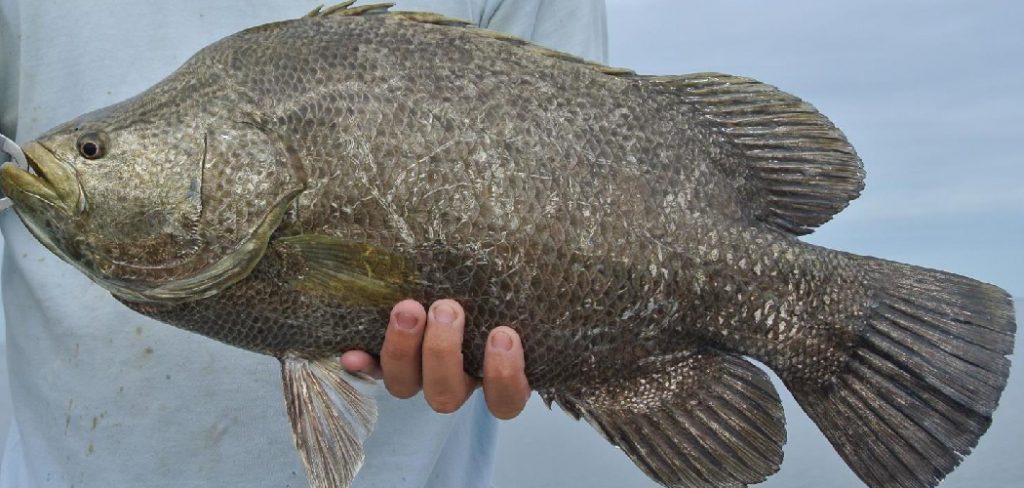
Knowing how to catch triple tail fish hinges significantly on understanding their unique behavior patterns. Tripletail fish are notably adaptive, often found floating on their sides near the surface, mimicking a leaf or debris to attract unwary prey. Their tendency to dwell near structures, whether natural reefs, shipwrecks, or man-made objects, necessitates a strategic approach to fishing that accounts for these behaviors.
Tripletail fishing offers numerous rewards, ranging from the thrill of the catch to the culinary delight of tasting this highly prized fish. Anglers appreciate the challenge of the tripletail’s cunning nature and fighting spirit, making it a sought-after species for sportfishing enthusiasts. Furthermore, targeting tripletail encourages sustainable fishing practices, as their habitats often coincide with ecologically significant areas that benefit from careful, responsible fishing efforts.
Identifying Tripletail Habitat and Behavior
A. Preferred Habitat of Tripletail Fish
Tripletail fish gravitate towards warm, coastal waters, often found around buoys, pilings, and in areas with floating debris or sargassum. They thrive in both inshore and offshore environments, showing a particular preference for areas where they can leverage their unique camouflage skills. Estuaries, mangroves, and the mouths of large rivers also serve as prime habitats for these fish, offering ample shelter and feeding opportunities.
B. Seasonal Movement and Migration Patterns
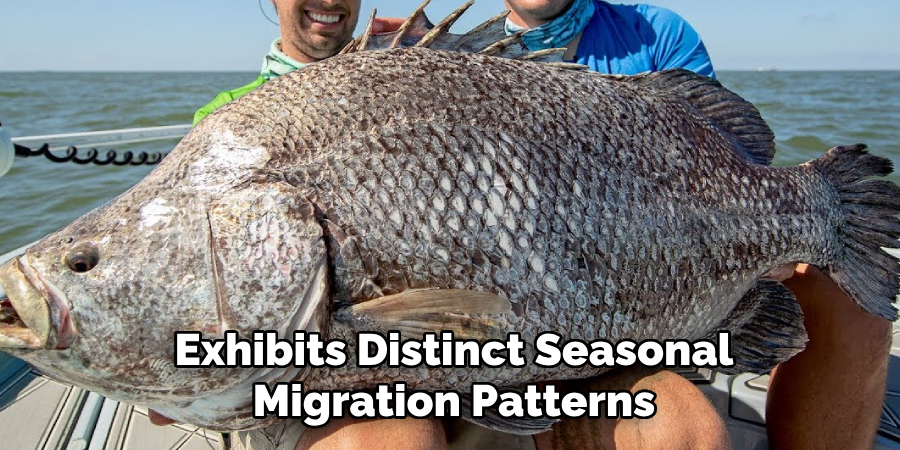
Tripletail exhibits distinct seasonal migration patterns, largely influenced by water temperature and breeding cycles. In general, they move towards warmer inshore waters during the spring to spawn, and as summer progresses, they are more commonly found nearshore and offshore.
In the fall and winter, tripletail may migrate to deeper, warmer offshore waters or move southward in search of favorable temperatures. Understanding these patterns is key for anglers looking to locate tripletail throughout the year.
C. Feeding Behavior and Prey Preferences
The diet of the tripletail primarily consists of small fish, crustaceans, and sometimes cephalopods. They are opportunistic feeders, often lying in wait near structures or floating objects to ambush prey.
Their predatory strategy involves mimicking floating debris or seaweed to blend into their environment, making them virtually invisible to unsuspecting prey. Knowing what tripletail eats helps select the right bait and lures, which is crucial in catching triple-tail fish efficiently and sustainably.
Selecting the Right Gear and Equipment
Selecting the right fishing gear is pivotal in mastering how to catch Triple Tail fish, as their unique behavior and habitats demand specific considerations.
A. Choosing the Proper Rod, Reel, and Line
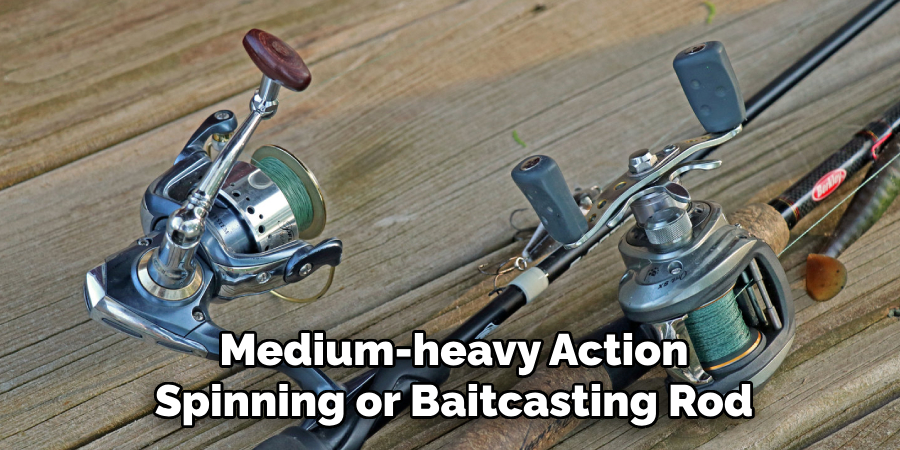
The ideal rod for tripletail fishing is a medium-heavy action spinning or baitcasting rod, measuring between 6.5 to 7 feet long. This allows for optimal casting accuracy and the power needed to handle the sometimes surprising strength of a hooked tripletail. Paired with the rod, a reliable spinning or baitcasting reel capable of holding at least 200 yards of the line ensures you’re well-prepared for any long runs.
For line, a 20-30 lb braided line is recommended for its sensitivity and strength. It is topped with a fluorocarbon leader of around 20 lb to maintain stealth while ensuring durability against the tripletail’s sharp gills and potential abrasive structures.
B. Selecting Suitable Terminal Tackle and Hooks
Regarding terminal tackle, simplicity often reigns supreme in tripletail fishing. A simple rig with a circle or J-hook (sizes 2/0 to 4/0) under a popping cork or a float can be incredibly effective. The use of circle hooks is encouraged to promote sustainable catch and release practices, as they are more likely to hook the fish in the corner of the mouth.
Weight should be adjusted based on current strength and depth, ensuring that the bait suspends at the right level without unnaturally sinking or floating.
C. Matching Bait and Lures to Tripletail Preferences
Tripletail are not overly picky eaters, but matching the hatch is always a sound strategy. Live bait such as shrimp, small crabs, and finger mullet are highly effective, especially when drifted near structures where tripletails are likely to hide.
For artificial lures, soft plastics that mimic the prey mentioned above can be useful, particularly in clear water conditions where tripletail may be more discerning. Additionally, topwater lures and flies can elicit exciting surface strikes, especially in cooler waters or during early morning and late afternoon when tripletails feed more actively.
How to Catch Triple Tail Fish: Locating Tripletail Hotspots
Finding the right spot to fish for a tripletail is vital for a successful outing. Knowing what to look for regarding habitat and environmental conditions can significantly increase your chances of locating these elusive fish.
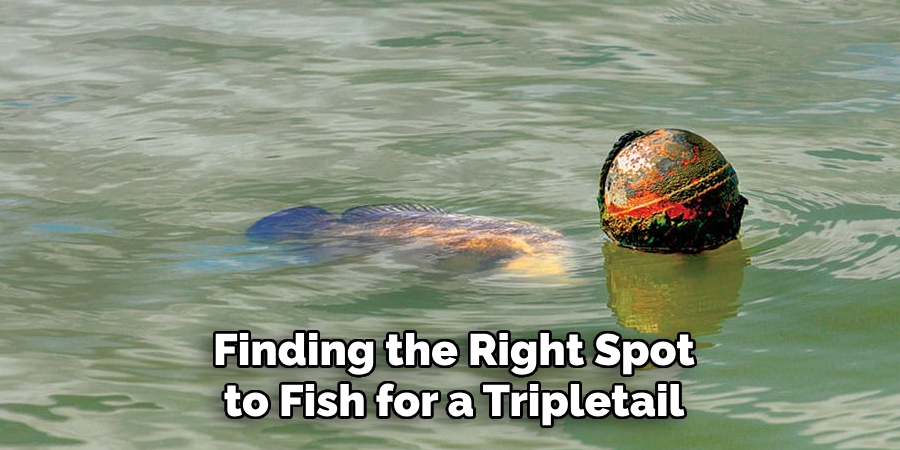
A. Identifying Structure and Floating Debris
Tripletails are known to gravitate towards structures and floating debris where they can easily camouflage themselves while waiting for prey. Look for buoys, marker poles, floating logs, and even seaweed mats. Man-made structures such as dock pilings and bridge supports can also attract tripletail, offering them both food and shelter.
Their affinity for floating objects means that any unusual floating debris can be a potential hotspot for tripletail fishing.
B. Paying Attention to Water Temperature and Clarity
Water temperature plays a crucial role in determining the presence of a tripletail. They prefer warmer waters, moving inshore during the warmer months to spawn. Monitoring water temperatures can give you a good indication of when tripletail might be moving into your fishing area. Additionally, water clarity can influence your fishing success.
While tripletail can be found in both clear and murky waters, clear conditions allow for better sight fishing opportunities, particularly when fishing around structures where these fish might be hiding.
C. Observing Bird Activity and Other Indicators
Birds can be excellent indicators of fish activity, including tripletail. Seabirds diving into the water can signal baitfish presence, which in turn can attract predatory fish like tripletail. Paying attention to bird activity can lead you to areas where tripletails are feeding. Additionally, look out for other signs of fish activity, such as surface disturbances, baitfish schools, and even changes in water flow around structures, all of which can indicate the presence of a tripletail.
How to Catch Triple Tail Fish: Fishing Techniques for Tripletail
Mastering various fishing techniques can significantly enhance your odds of catching tripletail. These adaptive predators can be found in many environments, from open waters to near structures. Understanding how to approach each scenario is key to success.
A. Casting to Structure and Debris
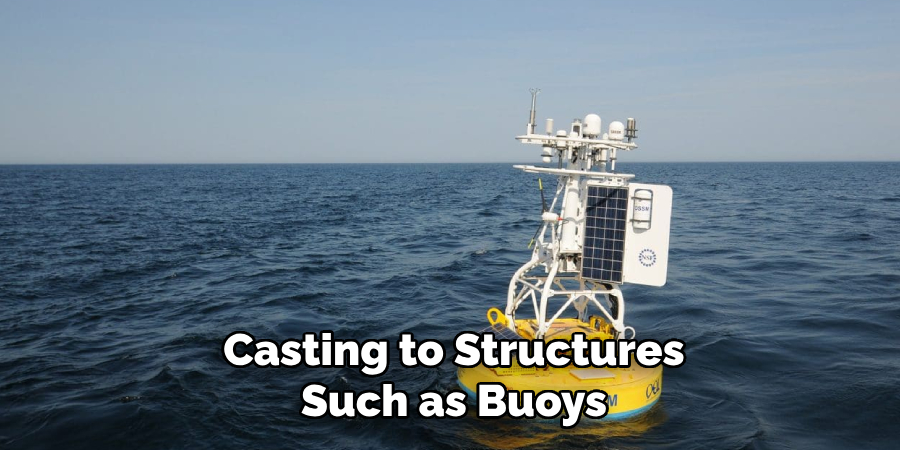
Casting to structures such as buoys, dock pilings, and floating debris is a quintessential technique for tripletail. It’s crucial to cast your bait or lure close enough to the structure to grab the attention of any lurking tripletail without getting snagged. Use a precise, gentle cast to place your bait in the potential path of the tripletail, mimicking a natural prey item. Patience is vital, as tripletail may take some time to emerge from their hideouts to investigate the bait.
B. Drifting or Slow Trolling Near Floating Objects
Drifting or slow trolling near floating objects leverages the natural current to present the bait in a lifelike manner. When employing this technique, it’s essential to maintain a slow, steady pace, allowing your bait to move naturally with the water flow around floating debris or structures. This can be especially effective in more open areas where tripletail may be suspended beneath floating objects waiting for prey.
C. Sight Casting to Surface Tripletail
Sight casting is an exhilarating way to target tripletails, particularly when they are visible near the water’s surface. This technique requires keen observation and quick reactions. Spotting a tripletail basking or feeding near the surface allows you to cast directly to the fish, providing an immediate and often exciting response. Use lightweight, natural-looking lures or bait for effective sight casting, and be prepared for a swift, powerful strike.
Employing these techniques, from the calculated placement of casts near structures to the thrilling immediacy of sight casting, can immensely upgrade your tripletail fishing adventures. Each method demands not only an understanding of the fish’s habits and habitats but also patience, precision, and the ability to adapt to the conditions and reactions of the tripletail.
Bait and Lure Selection
The effectiveness of your fishing expedition largely hinges on the choice of bait and lures. Understanding the preferences of tripletail is essential to making informed selections that will entice these elusive predators.
A. Live Bait Options for Tripletail
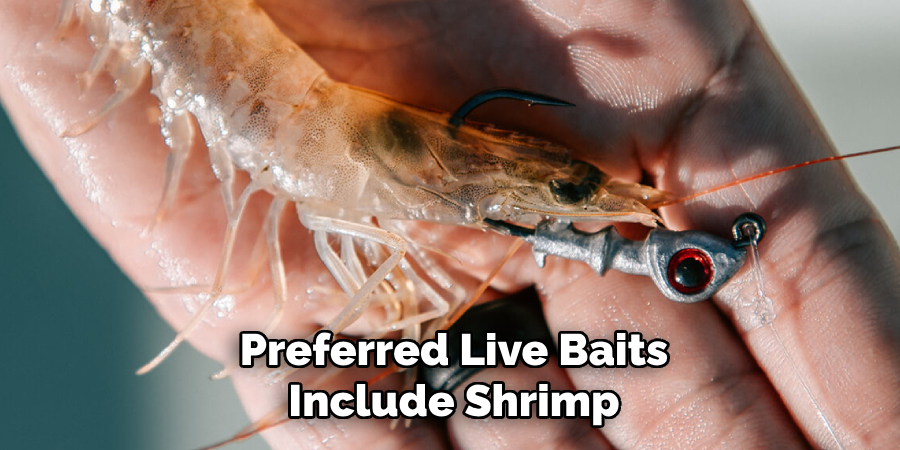
Live bait options that closely mimic the natural diet of tripletail can significantly increase your chances of a successful catch. Preferred live baits include shrimp, small crabs, and finger mullet, which should be presented to imitate their natural movements. Hooking live bait through the tail or behind the head allows for more natural movement, making it irresistible to tripletail lurking near structures or floating debris.
B. Using Artificial Lures to Target Tripletail
Artificial lures can be equally effective, especially when live bait is unavailable. Soft plastic lures that mimic shrimp or small fish are excellent choices. It’s essential to select lures that match the color and size of the natural prey in the area.
Top water lures and flies can also be effective, particularly in cooler waters or during active feeding times like early morning or late afternoon when tripletails are more likely to strike at surface prey.
C. Experimenting with Different Baits and Presentations
The key to successful tripletail fishing often lies in experimentation. Changing baits and altering presentations can be crucial when fish are present but not biting. Switching between live and artificial baits, varying retrieval speeds, and trying different depths can all trigger bites from finicky fish.
Ultimately, understanding the behavior of tripletail and adapting your strategies accordingly will enhance your fishing experience and success rate.
Hooking and Playing Tripletail
Successfully hooking and playing a tripletail requires patience, skill, and an understanding of this species’ unique behaviors.
A. Setting the Hook Properly
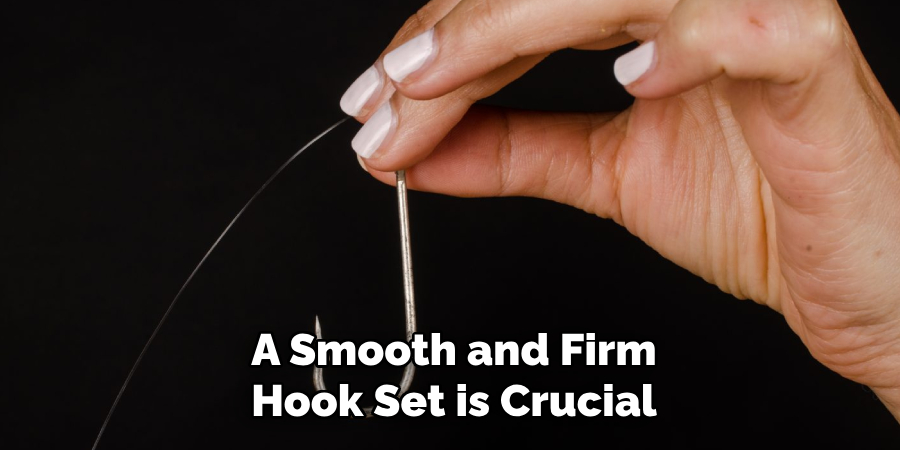
When a tripletail strikes, a smooth and firm hook set is crucial. Once the fish takes the bait or lure, pause briefly to allow it to turn back towards cover, which is its natural instinct. This momentary delay gives the fish time to fully take the bait into its mouth. Then, with a steady motion, set the hook firmly to ensure it penetrates the tough mouth of the tripletail. Avoid overly aggressive hook sets, as these can tear the bait from the fish’s mouth or break lighter fishing lines.
B. Fighting Tripletail Fish
Tripletail is known for its strength and stubbornness once hooked. After setting the hook, the initial run can be powerful, and anglers should be prepared for a vigorous fight. Keep the line tight and maintain steady pressure, adjusting the drag on your reel as necessary to allow the fish some give without breaking the line.
Be mindful of the tripletail’s tendency to head for structures. Skillful maneuvering and anticipating the fish’s movements are key to avoiding obstacles that could entangle or break your line.
C. Landing Tripletail Safely
Bringing a tripletail to the boat or shore requires cautious handling to avoid losing the fish at the last moment. Use a net large enough to comfortably contain the fish, and lead the tripletail gently towards it.
Avoid lifting the fish out of the water by the line or rod, as this can cause the hook to dislodge or the fishing gear to break under the weight. Once netted, quickly but carefully remove the hook, using pliers if necessary, to reduce harm to the fish, especially if practicing catch and release.
Safety Considerations
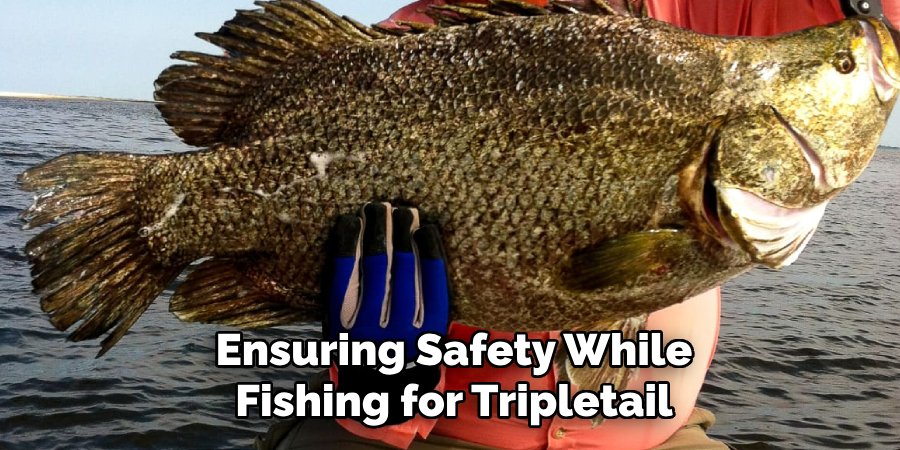
Ensuring safety while fishing for tripletail is paramount. The excitement and focus on landing a catch should never overshadow the importance of personal and environmental safety measures. Proper preparation and awareness can prevent accidents and health issues, making your fishing experience both enjoyable and safe.
A. Using Sun Protection and Staying Hydrated
Long hours under the sun can be detrimental without proper protection and hydration. Always apply a broad-spectrum sunscreen with a high SPF to all exposed skin and reapply it every two hours or after swimming or sweating. Wearing a hat, UV-protective clothing, and sunglasses can further shield you from harmful UV rays. Equally important is staying hydrated. Bring along and consume plenty of water to avoid dehydration, which can lead to heatstroke and impair your ability to fish effectively.
B. Watching for Hazards such as Strong Currents and Rough Seas
Awareness of your surroundings and understanding the water conditions are critical when fishing for tripletail, especially in areas with strong currents and rough seas. Always check weather forecasts and marine conditions before heading out and stay alert to changes while on the water. Avoid fishing alone in potentially hazardous areas. If you’re on a boat, ensure all safety equipment is accessible and in good working order.
C. Handling Fish Safely to Avoid Injury
Like many fish species, Tripletail must be handled with care to avoid injuries to both the angler and the fish. Use gloves to protect your hands from sharp fins and gills. Be especially cautious when removing hooks to prevent puncture wounds or cuts. If planning to release the fish, handle it as little as possible and ensure it’s properly revived before doing so to promote its survival.
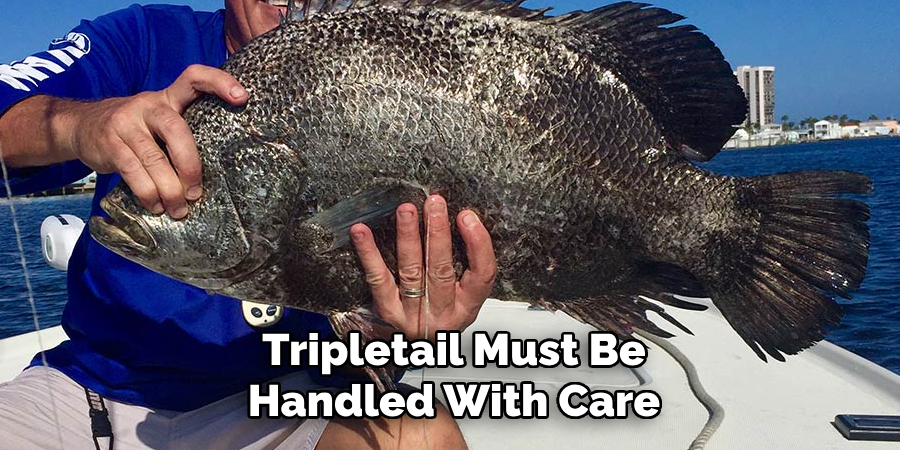
By adhering to these safety considerations, anglers can focus on the thrill of fishing while minimizing risks to themselves, others, and the marine environment. Whether it’s taking preventive measures against the sun, staying vigilant about water conditions, or handling fish correctly, safety is an integral part of a successful and responsible fishing adventure.
Conservation and Ethics
While the pursuit of tripletail is exhilarating, it also carries a responsibility to uphold conservation and ethical fishing practices. These guidelines ensure the sport’s future and protect the aquatic ecosystems that support these fascinating fish.
A. Practicing Catch and Release When Appropriate
Catch-and-release is a critical conservation tool, allowing anglers to enjoy the thrill of the catch while ensuring the health and sustainability of fish populations. When practicing catch-and-release, it’s important to handle the tripletail with care to minimize stress and injury.
Using circle hooks, keeping the fish in the water as much as possible, and ensuring a quick release all contribute to the fish’s survival post-release. This practice not only supports the species’ longevity but also maintains the balance of the ecosystem.
B. Following Local Fishing Regulations and Size Limits
Adherence to local fishing regulations, including size limits and season closures, is fundamental to conserving tripletail populations. These rules are based on scientific research aiming to preserve fish stocks by allowing them to reach maturity and spawn.
Before heading out, anglers should familiarize themselves with the most current regulations and ensure they are followed rigorously. Compliance contributes to the species’ sustainability and ensures that fishing practices are fair and legal.
C. Respecting the Marine Environment and Wildlife
The marine environment is a complex and delicate ecosystem that relies on each species and habitat playing its role. Anglers can contribute to its preservation by avoiding sensitive areas, reducing bycatch through selective gear and techniques, and minimizing their environmental impact.
Actions such as retrieving lost tackle, properly disposing of waste, and participating in habitat restoration efforts demonstrate a commitment to environmental stewardship. Respect for the marine environment and all its inhabitants ensures that the beauty and diversity of our oceans are preserved for future generations.
By practicing catch and release when appropriate, adhering to local fishing regulations, and respecting the marine environment and wildlife, anglers embody the principles of conservation and ethics. This responsible approach to fishing ensures the preservation of tripletail populations and the health of marine ecosystems, securing the future of angling for generations to come.
Enjoying the Experience
The essence of fishing for a tripletail transcends the mere act of catching fish; it’s a harmony of challenges, learning, and shared joy. This unique fishing experience offers tangible and intangible rewards, fostering a deeper connection with nature, oneself, and others.
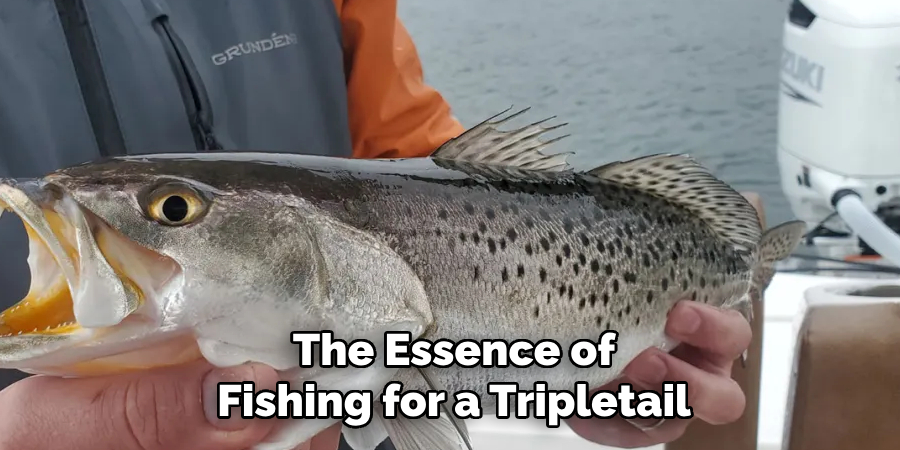
A. Embracing the Challenges and Rewards of Tripletail Fishing
Tripletail fishing presents a spectrum of challenges, from mastering the technique to understanding the behavior of this elusive fish. The patience and skill required can test even the most seasoned anglers.
However, the rewards of successfully landing a tripletail are immense. There’s a profound sense of accomplishment in overcoming these hurdles, augmented by the thrill of the catch itself. This exhilarating experience hones anglers’ abilities and deepens their appreciation for the sport and the aquatic world.
B. Learning from Each Fishing Trip and Improving Skills
Each fishing expedition is a lesson in itself, offering invaluable insights into the environment, fish behavior, and angling techniques. Mistakes made and challenges faced become stepping stones for improvement. Over time, anglers develop a refined understanding and skill set that enhance their fishing experience. This continuous learning process is what keeps the sport of tripletail fishing both challenging and rewarding.
C. Sharing the Experience with Friends and Family
Like many outdoor activities, fishing for a tripletail is enriched when shared with friends and family. It offers a unique opportunity to bond, creating lasting memories of excitement and camaraderie.
Sharing the joy of a catch or the solace of a quiet day on the water can strengthen relationships and introduce loved ones to the joys and responsibilities of angling. In these shared moments, the true spirit of fishing is realized, uniting individuals through a common passion and respect for nature.
By fully engaging with the experience—embracing its challenges, learning from each trip, and sharing moments with loved ones—angling for tripletail becomes more than a pastime. It transforms into a journey of personal growth, skill enhancement, and cherished social interaction, solidifying its place as a rewarding endeavor in the heart of its enthusiasts.
Conclusion
In our comprehensive guide to the art and science of tripletail fishing, we’ve explored techniques, strategies, and conservation practices that make this sport both challenging and rewarding.
We dove into the intricacies of locating, attracting, and ultimately landing tripletail. Anglers can increase their success rates by paying close attention to floating structures and the edges of coastal waters, employing the right baits, and mastering the finesse required in casting and retrieval.
For those drawn to the thrill of fishing, the elusive tripletail offers an exceptional experience. New and seasoned anglers alike are encouraged to pursue this unique species. The blend of patience, skill, and respect for the aquatic environment enriches one’s fishing acumen and fosters a deeper connection with the natural world.
Understanding the basic principles of how to catch triple tail fish is a gateway to countless memorable adventures on the water. Remember, the key to success lies in persistence, respecting the environment, and continually honing your skills through practice and observation. Keeping conservation at the forefront of your endeavors ensures a sustainable future for this fascinating sport, making each catch more rewarding.
In closing, tripletail fishing symbolizes much more than the pursuit of a single species. It’s a testament to the enduring allure of angling—a blend of challenge, discovery, and stewardship that rewards those who venture forth with unforgettable experiences and lessons learned beneath the open sky.
About the Author
Jennifer Branett is the author of Fishy Kayak and an expert in fish-related fields, with over 10 years of experience. Her work blends passion for fishing with a commitment to conservation.
Educational Background
Degree: Bachelor’s in Marine Biology
Institution: University of California, Santa Barbara
Specializations: Aquatic ecosystems, fish behavior, and sustainable practices
Professional Experience
Conservation Projects:
Collaborated with local organizations to restore aquatic habitats
Developed educational programs on sustainable fishing practices
Publications:
Authored articles for fishing magazines and environmental journals
Featured speaker at fishing expos and conservation conferences
Key Areas of Expertise
Fishing Techniques:
Kayak fishing strategies
Freshwater and saltwater fishing methods
Environmental Stewardship:
Advocacy for sustainable fishing
Promoting biodiversity in aquatic environments
Awards and Recognition
Recipient of the [Specific Award Name] for contributions to marine conservation
Recognized as a leading voice in the fishing community by [Organization/Publication Name]
Community Engagement
Workshops and Seminars:
Regularly hosts events to educate anglers on sustainable practices
Engages with youth programs to inspire the next generation of fishers
Online Presence:
Maintains an active blog sharing tips, stories, and conservation efforts
Engages with followers on social media to promote fishing ethics
Personal Interests
Enjoys kayaking in scenic locations
Passionate about photography, capturing the beauty of nature
Advocates for local conservation efforts in her community
